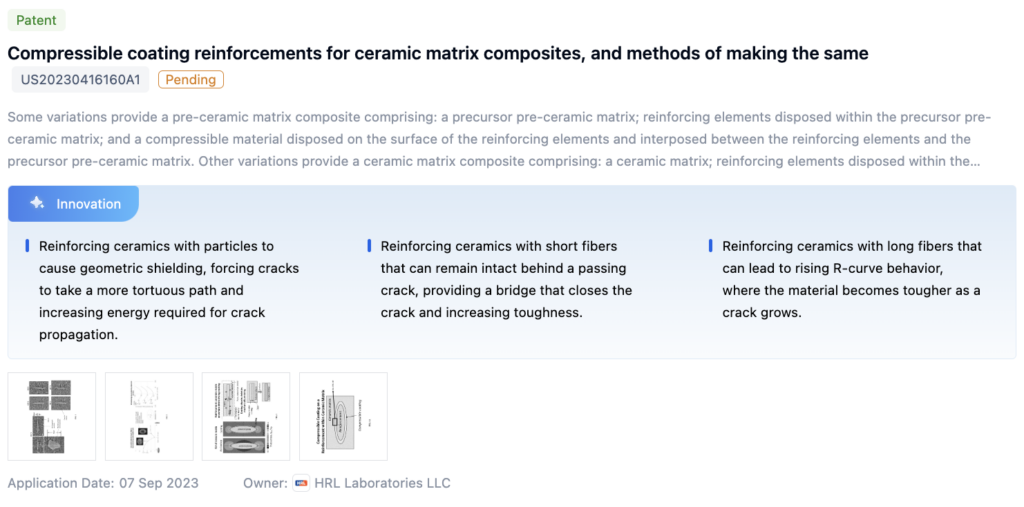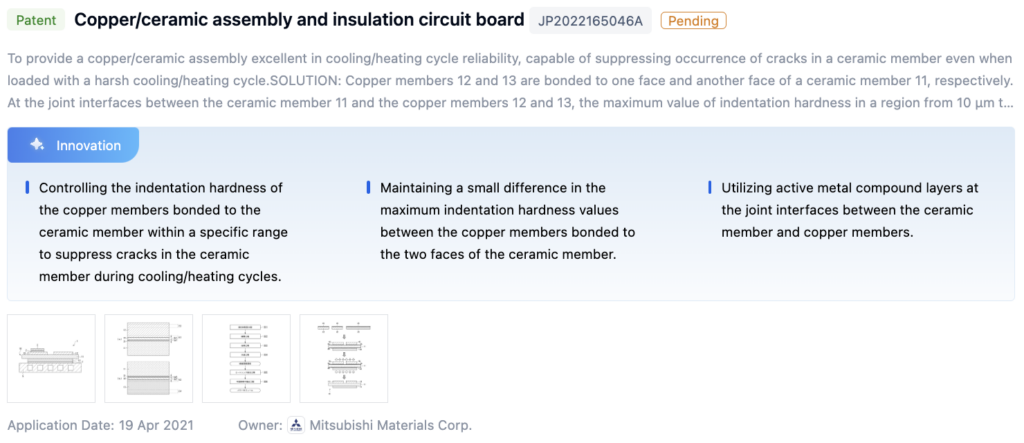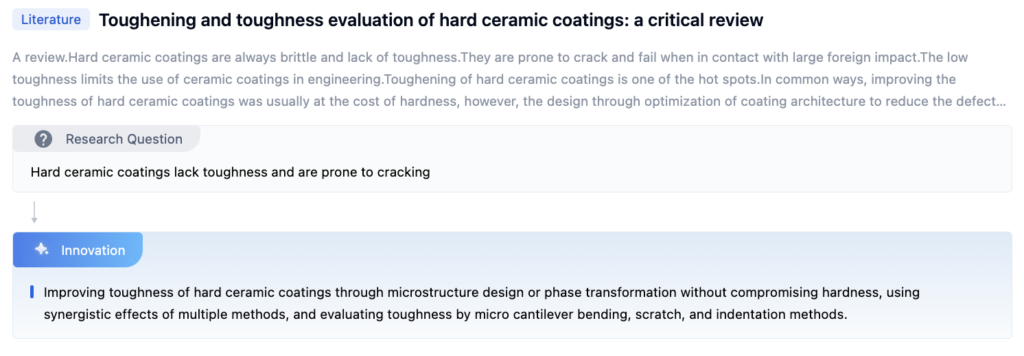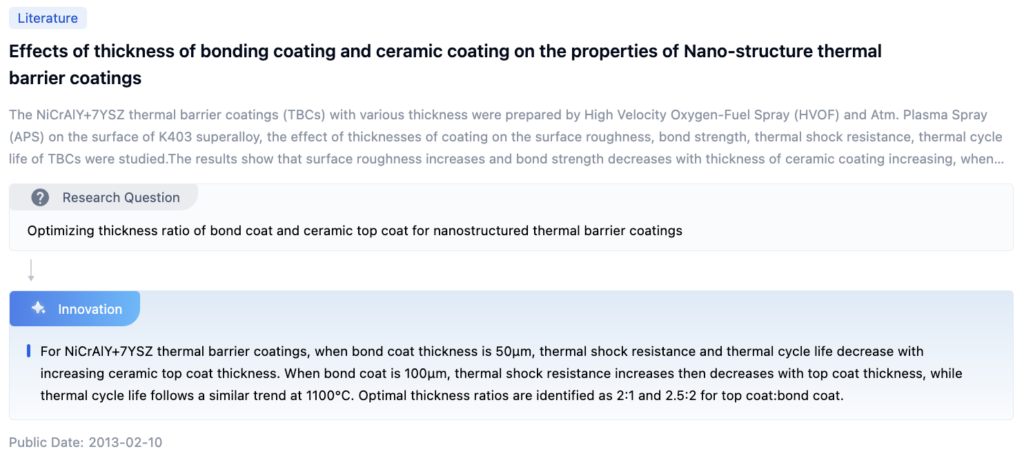
Ceramic Coating Technology Background and Goals
Ceramic coatings are widely used to enhance the durability and performance of materials, particularly in harsh environments. These coatings provide exceptional hardness, wear resistance, and thermal stability, making them suitable for industries such as aerospace, automotive, and energy. However, the inherent brittleness of ceramic coatings limits their application in situations where toughness is essential.
The primary goal is to improve the toughness of ceramic coatings to resist crack propagation and withstand impact loads without catastrophic failure. Strategies to achieve this include modifying the coating composition, optimizing microstructure, and developing multilayer coatings with different materials. Improving the toughness of ceramic coatings will enable broader applications, enhance component performance, and extend service life.

To get detailed scientific explanations of the ceramic coatings, try Patsnap Eureka TechResearch.
Market Demand for Durable Ceramic Coatings
The demand for durable ceramic coatings is increasing across various industries due to their superior properties such as high hardness, wear resistance, and chemical inertness. Key applications include:
- Aerospace: Protecting turbine blades and combustion chambers from high temperatures, erosion, and corrosion.
- Automotive: Enhancing wear resistance of engine components like piston rings, cylinder liners, and valves.
- Energy Sector: Protecting components in power generation, oil, and gas exploration from erosion and corrosion.
- Manufacturing: Applying coatings to cutting tools and molds to improve wear resistance, hardness, and thermal stability.
The growing demand for high-performance materials is expected to drive further growth in the market for durable ceramic coatings.
Current State and Challenges of Ceramic Coating Toughness

Ceramic coatings offer hardness and thermal stability, but their brittleness and low fracture toughness limit their use in impact-resistant applications. Challenges include:
- Intrinsic Brittleness: Strong ionic or covalent bonding in ceramics leads to brittleness, making them prone to failure under impact or cyclic loading.
- Defects: Pores, inclusions, and microcracks act as stress concentrators, exacerbating brittleness.
- Thermal Expansion Mismatch: Differences in thermal expansion between the ceramic coating and substrate can cause residual stresses and lead to delamination or cracking.
- Deposition Techniques: Factors like deposition temperature and pressure impact coating density, grain size, and defect concentration, affecting toughness.
Research is focused on addressing these challenges by improving coating composition, microstructure, and deposition methods.
Evolution of Ceramic Coating Technologies

Existing Solutions for Enhancing Ceramic Coating Toughness
High Toughness Ceramic Materials and Composites
- Reinforced Ceramics: Adding fibers or whiskers to ceramic matrices increases fracture toughness. Examples include ceramic matrix composites, nanocomposites, and multi-phase ceramics.
- Controlled Microstructure: Techniques like grain boundary engineering and introducing secondary phases enhance toughness through crack deflection, bridging, or transformation toughening.
- Thermal Barrier and Wear Resistance Coatings: High toughness ceramic coatings are used in thermal barrier coatings for high-temperature environments and wear-resistant coatings for cutting tools.
Preparation Methods for High Toughness Ceramic Coatings
- Composite Materials: Using ceramic-metal or ceramic-ceramic composites improves fracture toughness.
- Nanostructured Materials: Nanoparticles and nanofibers enhance toughness through grain boundary strengthening and crack deflection.
- Novel Processing Techniques: Methods like spark plasma sintering and hot isostatic pressing improve coating density and toughness.
Testing and Evaluation of Ceramic Fracture Toughness
- Indentation Testing: Techniques like Vickers indentation measure fracture toughness by analyzing crack patterns.
- Non-Destructive Testing: Methods such as ultrasonic testing and acoustic emission monitoring evaluate toughness without damaging the coating.
Key Players in Ceramic Coating Industry
Murata Manufacturing Co. Ltd.
- Focuses on enhancing toughness through nano-particles and advanced sintering techniques.
HRL Laboratories LLC
- Develops ceramic coatings with improved toughness using advanced material science techniques.
The Research Foundation of The State University of New York
- Incorporates bio-inspired design principles to improve ceramic coating toughness.
Shanghai Institute of Ceramics, Chinese Academy of Sciences
- Uses composite materials to enhance the toughness of ceramic coatings.
ZYP Coatings Inc.
- Specializes in high-performance ceramic coatings with superior toughness.
Core Innovations in Ceramic Coating Toughness
Patent 1: Compressible Coating Reinforcements for Ceramic Matrix Composites
- Core Points:
- Geometric Shielding: Particles force cracks to take a tortuous path, increasing energy required for crack propagation.
- Short and Long Fibers: Provide crack bridging and rising R-curve behavior, improving toughness.

Patent 2: Copper/Ceramic Assembly and Insulation Circuit Board
- Core Points:
- Indentation Hardness Control: Maintains hardness within a specific range to suppress cracks during thermal cycles.
- Active Metal Compound Layers: Enhance bonding and reduce stress at interfaces.

Paper 1: Toughening and Toughness Evaluation of Hard Ceramic Coatings
- Core Points:
- Microstructure Design: Enhances toughness without compromising hardness, using multiple synergistic methods.

Paper 2: Effects of Bonding and Ceramic Coating Thickness on Properties
- Core Points:
- Optimizing Thickness Ratios: Improves thermal shock resistance and thermal cycle life of nanostructured thermal barrier coatings.

Potential Breakthroughs in Ceramic Coating Durability
High Toughness Ceramic Materials
- Composite and Nanostructured Ceramics: Incorporating reinforcing phases improves resistance to cracking and failure under stress.
Testing Methods for Ceramic Coating Toughness
- Fracture Toughness Evaluation: Inducing controlled cracks or indentations to analyze propagation and deformation patterns.
Ceramic Coatings for Thermal Barrier Applications
- Improved Toughness: Enhances resistance to thermal cycling and mechanical stresses.
High Toughness Ceramic Coatings for Wear and Impact Resistance
- Enhanced Durability: Designed to withstand abrasive environments and impact loads.
Environmental Impact of Ceramic Coating Production
The production of ceramic coatings involves processes that can impact the environment, such as emissions of particulate matter and gaseous pollutants during coating application. High-temperature curing processes also contribute to greenhouse gas emissions. Waste generated during production, such as spent solvents and unused materials, poses disposal challenges. Strategies to mitigate these impacts include developing environmentally friendly formulations, efficient waste management systems, and energy-efficient technologies.
Regulatory Landscape for Ceramic Coatings
The regulatory landscape for ceramic coatings involves controlling hazardous substances and emissions, ensuring worker safety, and complying with industry standards. Regulations vary by region, and manufacturers must stay informed about specific requirements and changes. Compliance with these regulations is essential for promoting innovation while ensuring health, environmental protection, and safety.
If you want in-depth research or a technical report, you can always get what you want in Patsnap Eureka TechResearch. Try now!

